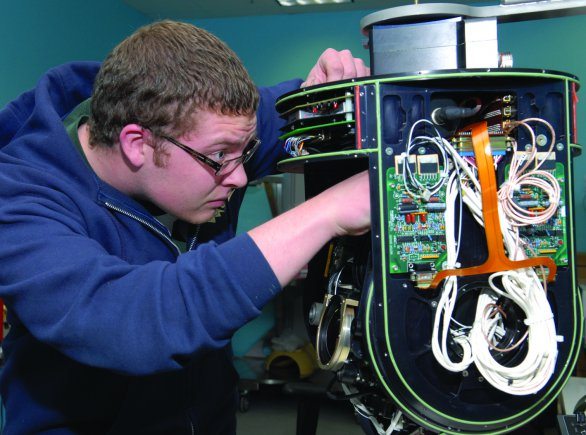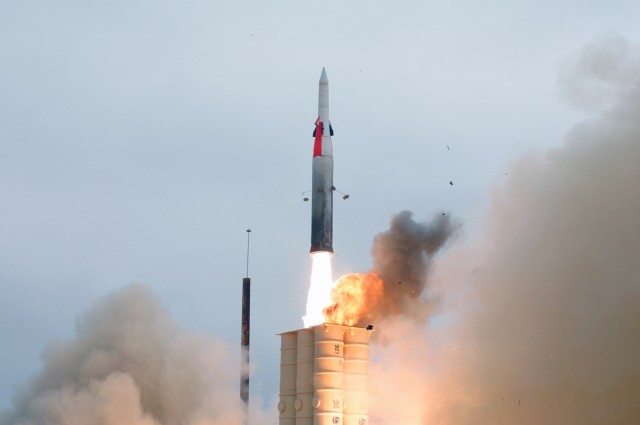Well-trained and skilled depot employees maintain and support the military’s vast array of electro-optics/night vision, EO/NV, systems here and around the globe.
Technicians overhaul, repair, modify, test and install EO/NV systems for all branches of the service and foreign military service, or FMS, customers.
Tobyhanna’s capability extends beyond night vision devices and scopes to include support of systems such as driver viewers, laser range finders and Target Acquisition Systems, Bradley Fighting Vehicle Targeting Systems, forward looking infrared, known as FLIR, and infrared sensors, according to Joseph Fantanarosa, chief of the Electro Optic/Night Vision Division.
Tobyhanna also maintains and Resets the Vehicle Optics Sensor System , or VOSS. The gyrocam VOSS is a remotely controlled, gyro-stabilized, multi-mission surveillance system that can acquire and track targets in bright light, low light, or no light conditions to locate improvised explosive devices, or IEDs, snipers and other threats at greater stand-off distances. Targets can be viewed using a color camera, night vision camera, or an infrared camera, all contained in the same unit.
“We’ll be supporting the VOSS I Reset and are currently providing maintenance to VOSS I and II systems for training facilities at 12 locations,” said Mark Warner, electronics mechanic leader in the Systems Integration and Support, SIS, Directorate’s Tank Thermal/Common Modules Branch. “All systems will be maintained or Reset to fill mission capable status requirements.”
Technicians also provide Reset capability for one of the latest systems to be repaired by Tobyhanna — the AN/TAS-8 Long Range Advanced Scout Surveillance System, LRAS3. Depot engineers and technicians are developing a complete overhaul and test facility for the LRAS3 and its components.
“Starting in January, this facility will include complex optical test stations, a full line-of-sight laser range with multiple targets at near and far locations, an environmental stress screening system and various other test and repair equipment,” said Mark Viola, chief of the C4ISR Maintenance Engineering Division, Production Engineering Directorate.
“Night vision and imaging systems expertise has enabled Tobyhanna to support the Army’s slogan ‘We Own the Night,'” said Frank Zardecki, deputy commander. “Tobyhanna has been repairing electro-optics and night vision equipment since the 1990s, so there are literally hundreds of years of combined experience on the shop floor and in our engineering department. It’s this depth of experience that provides a solid base to take on new challenges.”
The depot boasts a comprehensive mix of test equipment and facilities to handle a variety of EO/NV workload. However, senior leaders recognize that the work force is its strongest asset so they consistently invest in training, development and facilities increasing the depot’s capability edge.
Additionally, as advocates of continuous improvement, employees frequently use Lean tools such as process planning events to streamline operations and shop layout.
“The growth of EO/NV is due to our exceptional work force that can handle just about any challenge,” said Col. Gerhard P.R. Schröter, depot commander. “With that foundation, we also have the flexibility in our facility to rearrange workspace and personnel to increase our capacity.”
On the shop floor, technicians have dedicated and flexible test equipment at their disposal that allows accurate repair and overhaul of the systems. Tobyhanna also maintains a considerable number of specialized test equipment and test beds that are system-specific.
And, to keep customer costs down, the in-house engineering staff is always looking for opportunities to re-host testing on the more flexible and cost effective Automated Test Systems, or ATS, platforms, according to Viola. “These ATS can be programmed to test components from any number of different EO/NV systems,” he said.
“Tobyhanna has the highest concentration of highly skilled and well-trained high-tech electronics mechanics supported by one of the most robust engineering staffs in the Defense Department industrial base providing Tobyhanna the capability to adapt and support new electro optics and night vision systems,” Schröter said.
The shop also maintains a ball grid array solder flow station, a new way of soldering components to a circuit board. Connections are under the component rather than protruding out of the component. There is an X-ray inspection station for very precise replacement of components and screen for adequate solder flow. Cryogenics cooler test and charging stations are used to charge coolers with helium gas and measure the performance of the rebuilt coolers.
“There are class 10K, 100K and 300K clean-rooms on hand for working dust-sensitive components and conducting optical bench testing,” Fantanarosa said. “The clean rooms house modular universal laser equipment, automatic laser instrumentation measurement systems, laser optical bench, boresight collimator and other precision testing and repair equipment. The shop also maintains a full service EO calibration lab.”
The boresight collimator uses electronic, optical and mechanical components to produce two parallel beams of energy which are used to align the night sight to the optical sight.
Outdoor test capabilities include a 500 meter laser test range. All laser systems are operationally checked at the Laser Range Test Facility for proper functionality and accuracy. Preparations for LRAS3 will add another 500 meter, and 1.5 and 7.5 kilometer ranges.
“Tobyhanna’s engineering team is dedicated, innovative and extremely knowledgeable, and backed by experienced technicians who understand the different systems,” Zardecki said. “Together they develop effective solutions that streamline repair methods, decrease turn-around time, improve quality and reduce cost.
Viola explained that customers regularly come to Tobyhanna looking for repair services, but lack crucial technical data. Using a number of different techniques, employees here are able to develop new repair and overhaul capabilities.
“For example, we have in-house capabilities to develop test programs using automatic test equipment,” Viola said. “Technicians can also build system mockups and develop bench tests to provide organic repair capabilities, plus modify existing test platforms to gain capability.”
Communications Electronics Evaluation Repair Team, or CEER–T, members test and repair night vision systems and Single Channel Ground and Airborne Radio Systems, known as SINCGARS, at stateside and overseas locations. Teams range from three to eight people.
“The CEER-T program was developed to have reliable operational equipment available for our warfighters to train with when they return from deployment and return them to fully mission capable status prior to future deployments,” said Mark Coviello, chief of the Wide Band Components Branch, Communications Systems Directorate. “Units returning from the fight send their equipment to post installation maintenance sites to support their Reset requirements. CEER-T technicians are on site at those installations to support quicker turnaround of equipment than if the equipment is sent to Tobyhanna.”
Tobyhanna sends CEER-T technicians to Reset night vision goggles on site at places such as Fort Bragg, N.C., and Joint Base Lewis McChord, Wash. This process speeds return of the assets to the warfighter and trims packaging, handling and transportation costs for the customer.
Personnel from Intelligence, Surveillance and Reconnaissance’s Image Optics/Laser Branch began the CEER-T program in November 2007. Since then, the highly trained and skilled technicians have repaired over 253,000 night vision goggles. They completed over 100 CEER-T missions at 29 separate unit home stations, in U.S. and overseas locations, Resetting the assets to 10/20, plus special technical inspection and repair, STIR, standards.
“The 10/20 standard assures that a system is mission capable, which may only require that components are repaired and tested,” Fantanarosa said. “STIR means that a system is brought to mission capable status by installing and testing new components at Tobyhanna.”
Assets that have been tested and repaired via CEER-T include the AN/PVS-7A, AN/PVS-7B, AN/PVS-7D and AN/PVS-14 Night Vision goggles.
Most recently, Tobyhanna partnered with the original equipment manufacturer and the program manager to refinish and establish functional test requirements for the Common Remotely Operated Weapon Station, or CROWS II. Tobyhanna has technicians trained with test stations and special tooling in place to repair the mainframe and right side assemblies’ electronics. CECOM Headquarters provided training to Tobyhanna technicians on the CROWS II heads-up display.
Tobyhanna also works with Picatinny Arsenal, N.J., to manufacture an at-platform diagnostic test capability for the CROWS II M153 Protector weapon system. Tobyhanna completed the final layout for the mechanical and electrical design, provided a total drawing package and delivered the first article prototypes.
“In-house shops manufactured the test boxes and internal circuit boards, incorporated the test boxes into transit cases and manufactured the test box interface cables,” said Michael Verrastro, chief of the depot’s Bradley Fighting Vehicle Branch. “Once accepted by the customer, there is potential to build another 6,000 kits.”
In addition, Tobyhanna is responsible for the sustainment of the guidance and control systems in Air Force and Navy Sidewinder infrared, heat seeking missiles.
Near term, Tobyhanna is supporting sophisticated systems such as the Base Expeditionary Targeting and Surveillance System — Combined in the field and aggressively pursuing other gimbel (ball mounted, continuous swivel capability)/multi sensor systems, plus unmanned aircraft systems sensor payloads. A core depot assessment is under way at Tobyhanna for the AN/AAS-53 Common Sensor Payload. Additional airborne reconnaissance workload is also being explored via Program Manager Aerial Reconnaissance, Exploitation and Sensors.
“Tobyhanna will always adapt to support new electro optics and night vision systems,” Schröter said. “The men and women of our armed forces can count on Tobyhanna for superior service worldwide to help keep them one step ahead of our adversaries.”
Tobyhanna Army Depot is the Defense Department’s largest center for the repair, overhaul and fabrication of a wide variety of electronics systems and components, from tactical field radios to the ground terminals for the defense satellite communications network. Tobyhanna’s missions support all branches of the Armed Forces.
About 5,400 personnel are employed at Tobyhanna, which is located in the Pocono Mountains of northeastern Pennsylvania. Tobyhanna Army Depot is part of the U.S. Army CECOM.
Headquartered at Aberdeen Proving Ground, Md., the command’s mission is to research, develop, acquire, field and sustain communications, command, control computer, intelligence, electronic warfare and sensors capabilities for the Armed Forces.











